Correspondent of South -Eastern Asia
It looked small at the beginning, in the wide space of the Pacific Ocean. However, as we approached the USs Carl Vinson, she completed the view from the back of Osprey Tilt’s rotor who was taking us there, her deck filled with the best planes of war. At nearly 90,000 tonnes, and more than 300 meters in length, Carl Vinson with nuclear power is one of the largest ships ever built.
Viewing its FA18 and F35 fighter jets jumping into the air every minute or two of the carrier vapor catapults is an experience of raising the spine, a procedure managed with impressive composition by the crew on the crowded deck.
A premature pumpkin of the Pacific that washed us and everything else did not slow them down.
Even after years of rapid progress in Chinese military skills, the United States is still incomparable in its ability to design strength anywhere in the world with its 11 super-transporters fleet.
But does it make more sense a recent meaning, does it make sense more, does it make sense to a $ 13 billion ($ 10 billion) plane carrier, which the latest Chinese missiles can sink – especially in Donald Trump’s era?
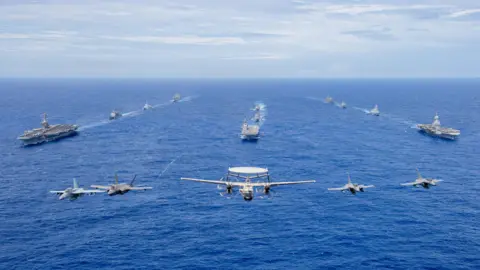 BBC/Natalie Thomas
BBC/Natalie ThomasWe were invited to Carl Vinson to see another side of the American carrier’s strategy, one that emphasizes American friendliness and willingness to work with allies – something you don’t hear much in Washington these days.
Carl Vinson was attending a drill with two other aircraft carriers and their accompanying destroyers from France and Japan, about 200 km east of the Philippines. In the absence of the wars to fight, the groups of US carriers spend most of their time doing this, learning how to operate with allied marines. Last year they held an exercise that joined ships from 18 Marina.
This was smaller, but was the first in the Pacific to include a French carrier for more than 40 years.
Making the issue for alliances
Down in the massive hangar, down the deck of noisy flight, Rear Adm Michael Woje, commander of Carl Vinson’s strike force, was sitting with his French colleague, Rear Adm Jacques Mallard of Charles de Gaulle carrier, and his Japanese colleague of ADM ADM NATSUI Takashi of Kaga, which is in the process of transforming the first aircraft carrier of Japan since World War II.
Charles de Gaulle is the only warship in the world that matches some of the skills of US super-transporters, but even then it’s only half their size.
All three admirals were filled with bonhomie.
The scenes filled in Europe, where President Trump’s men were capturing the book of rules that underlined the international order for the last 80 years, and telling the Allies once they were now, seemed a world away.
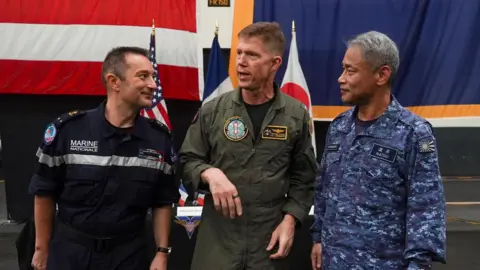 BBC/Natalie Thomas
BBC/Natalie Thomas“Our network of strong alliances and partnerships, such as what we share with France and Japan, is a major advantage of our nations as we face our collective security challenges,” Adm Woime said. In the impeccable English Adm Mallard agreed: “This exercise is the expression of a willingness to better understand one another and to work for the protection of compliance in international law.”
No one mentioned the new radical views emanating from Washington, nor did they mention an increasingly affirmative China, though Adm Natsu may have both in mind when he said that Japan now found himself in the “heavier environment and security complex.
Down in the corridors of Steel Warren, which make up the living neighborhoods of 5,000 men and women in Carl Vinson, the official portraits of the young president and vice president were already addicted, that of Trump with his now well -known Pugillyist splendor. We were not allowed to interview the crew, and politics would have been out of bounds anyway, but some of those on board were curious what I thought about the new administration.
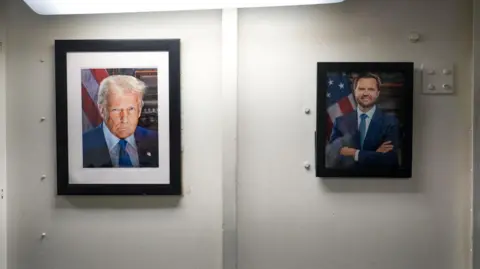 BBC/Natalie Thomas
BBC/Natalie ThomasInternet access to board is spotty, but they maintain contact with the home. We were told that they even receive shipments to Amazon while at sea, selected from certain points of the meeting.
It is a straight bet then there is a lot of discussions on what President Trump has in the store for these Navy giants. Elon Musk has already pledged to bring his cost of breaking the cost to the Pentagon And his $ 900 billion budget, and Defense Secretary Pete Hegseth has welcomed that, although he stressed, the Pentagon is not USAID which President Trump has pledged to close.
In the hangar we looked at the crew holding the plane, surrounded by packaging cases and spare parts. We were warned not to film any exposed part of these technological miracles for fear of discovering classified information. We couldn’t even risk touching the F35 fighters, who have a highly expensive high -layer special layer to help hide them from the radar.
They showed us “Jet Shop” where they repair and try the engines, a technician who identified themselves as ‘082 Madeiro’ explained that they needed to transport enough spare parts to keep the planes flying in long dislocations, and that After a certain number of engine schedule they had to be completely replaced, whether or not they were wrong. He had a whole new engine in his big packaging next to him. Cost, about $ 15 million.
Here to stay?
Carl Vinson’s direction costs about $ 700MA year.
So will the Trump administration take a knife in the Pentagon budget? Hegseth has said he believes he has considerable efficiency to find. He has also openly music for the value of aircraft carriers. “If our entire energy projection platform is a plane carrier, and if 15 hypersonic missiles can remove our ten aircraft carriers in the first 20 minutes of the conflict, what does it look like?” He said in an interview last November .
The debate over the service of aircraft carriers is not new. It returns immediately when they first appeared a century ago. Critics today argue that they are very vulnerable to the latest generation of chinese ballistic and hypersonic missiles, forcing them to stay at a distance from the Chinese coast that would put their plane outside the borders. The money, they say, would be better spent on younger technology.
 BBC/Natalie Thomas
BBC/Natalie Thomas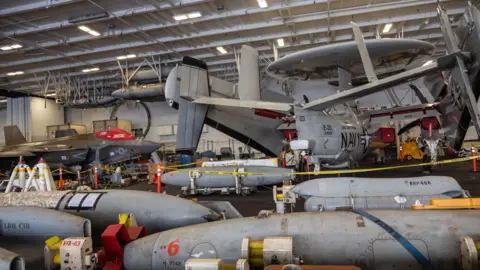 BBC/Natalie Thomas
BBC/Natalie ThomasSomething something archaic about these massive, steel -welded knees, which seemed to have their peak in the 1940s Pacific War. However, in the wide area of the ocean, with few air fields, it seemed difficult to do without them. Proponents argue that, with their accompaniment of the governed missile destroyers, the super carriers can be well protected, and that they are still difficult to sunk. Reduce these carriers, to perform only helicopters or planes that can be lowered and removed vertically as many places have done, and you end up with boats that are even more vulnerable.
It is worth noting that China also believes in the value of aircraft carriers; It has already built three. And as floating symbols of American prestige, they can appeal to President Trump, a man known for his love for the fiery structures, despite the economic arguments for and against them.
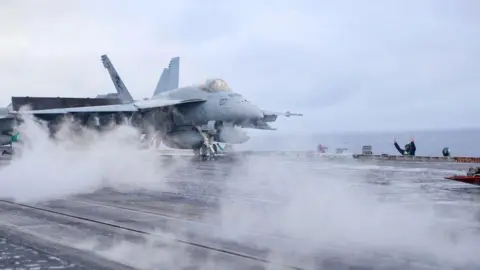 BBC/Natalie Thomas
BBC/Natalie ThomasIn his hearing about the Senate’s confirmation, Pete Hegseth said the Trump administration would give preference to increased shipbuilding, though he did not say how this can be achieved. The US has only four maritime sites left; China has, with some estimates, more than 200 times the capacity of the construction of the Sh.BA ships he also told his counterparts in Japan and South Korea that he wanted to deepen their protection cooperation with them. Europe may be on its own, but it seems that Asian allies will receive the attention of this white house as it focuses on the strategic challenge presented by China.
Three new Ford class nuclear carriers, the next generation after Carl Vinson, are currently under construction, though two will not be in service until the next decade. The plan is to complete ten from this new carrier class, and so far there has been no indication that the Trump administration wants to change it. For all her many critics, the American super-transporter is probably here to stay.
